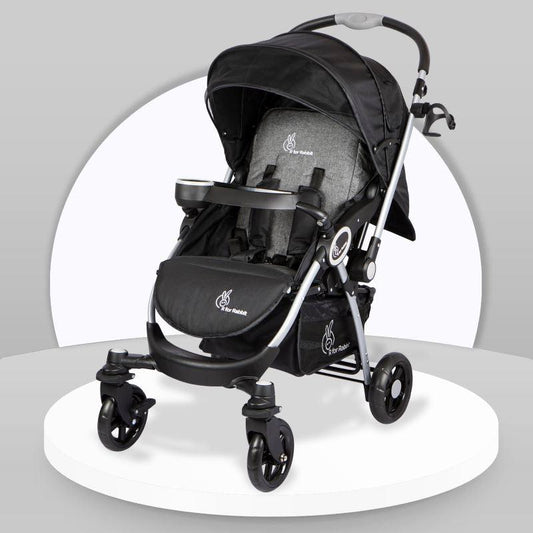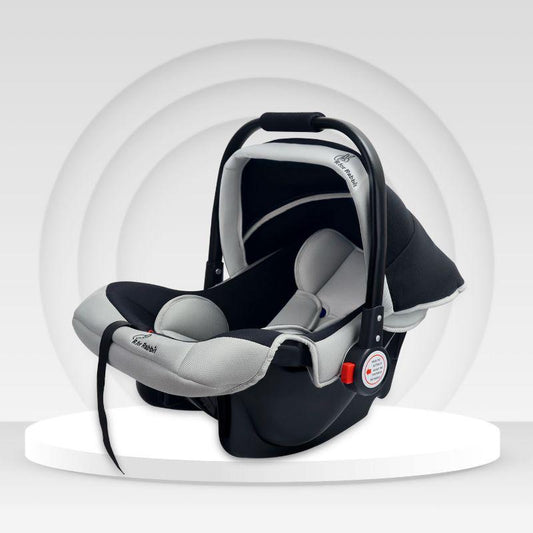How to Soothe a Crying Baby: Expert Tips Every Parent Should Know

Infants spend about 2-3 hours daily crying during their initial weeks of existence. The baby's natural crying behavior is expected, yet it creates tremendous distress for exhausted parents.
The American Academy of Pediatrics declares that crying is the primary method babies use to express themselves. Knowing baby-soothing techniques comforts all parents regardless of their experience level.
This guide will explain why babies cry, how to soothe them effectively, and some scientifically backed techniques that actually work.
Understanding Why Babies Cry
All babies get very fussy and start crying. Most babies cry for 2 to 3 hours daily in the first 6 weeks. So, how to soothe a crying baby?
5 Common Crying Reasons for a Baby

1. Hunger
The early hunger signs of fists moving to their mouths or lip-smacking indicate the need to get them their bottle.
2. Discomfort
Too hot, too cold, wet diaper, wanting to move; anything can cause your baby discomfort. So, keep checking on your baby to ensure they are at the right temperature. And are not wet.
3. Tiredness
Newborns sleep for a long period. They rest for around 16 to 18 hours of a day. So, if your baby does not get the right sleep, it may lead to a slew of tears.
4. Overstimulated
New to the world can be too much for babies. With all to see and all to hear going on everywhere around them, it can be overwhelming for your baby.
5. Need attention
Sometimes babies just want to be held or want attention. Since they cannot communicate that, crying is their best option.
Recognizing the Different Crying Patterns
Cries indicate babies' needs, and cracking the baby cry code might help you act fast and appropriately.

1. NEH (Hungry cry)
When our baby is hungry, and cries are long, the sound will be low-pitched and repetitive. However, the cry might get longer and louder as the hunger grows.
2. HEH (Discomfort cry)
Babies cry on and off when fussy. This kind of crying, like other kinds, gets more intense the longer it lasts.
3. EAIR (Gas or Colic cry)
If your baby has colic or pain, they will cry for long hours. They may even display stiff limbs, clenched fists, and an arched back. So, they will appear extremely uncomfortable.
4. OWH (Sleepy Cry)
When a baby makes this sound and rubs its eyes, it indicates that it is sleepy. If you ignore this scream, your baby may fuss and be hard to calm.
5. EH (Burp Cry)
EH sounds very similar to a discomfort cry, but it is soft and small. This sound indicates that your baby has an air bubble stuck in its food pipe and wants to burp.
Immediate Steps to Calm a Crying Baby
Trying to understand 'How to soothe a crying baby?’ In this section, we will discuss a child's basic needs and some comforting techniques.
Two Basic Needs to Re-check in a Baby
1. Your baby is fed and has a clean diaper
A growling stomach and wet diapers will make your child uncomfortable, making them cry. Therefore, make sure that your child is not hungry or the diaper is not wet.
2. Assess for signs of illness
If your baby is not hungry or does not have a wet diaper, then check the signs of illness. Re-check if your baby has gas or is hot or is cold.
3 Comforting Baby Soothing Techniques
If you want to take better care of your newborn baby, then try the following baby-soothing technique and make your life simpler:
1. Holding and gentle rocking
When comforting your baby, you should place them near your body. You can offer them gentle rocking motions that move them. Babies recognize familiar scents from loved ones through which physical closeness to their body helps them relax.
2. Speaking or singing softly
Babies recognize their mothers' voices, especially during times of distress. To soothe a baby faster, you should speak or sing to them softly.
3. Offering a pacifier
Giving a pacifier to your baby will calm them down. This will be a great way to help you soothe your baby. And stop them from crying.
4 Effective Baby Soothing Techniques
When learning ‘How to soothe a crying baby?', try these five most effective baby soothing techniques.
1. Swaddling
You can secure your baby with a large blanket during swaddling to create a feeling of security. This practice of swaddling them in a blanket allows your baby to experience a similar environment to their parental period.
2. Gentle Motion
The act of rocking your baby with gentle movements provides a womb-like experience that leads to calming effects on the baby. The rocking chair and swing provide a gentle motion that helps the baby feel comfortable.
Stroller walks provide an excellent opportunity to calm your baby. A different environment serves as an effective way to calm down a crying baby.
3. White Noise
The calming noises aid the infant in remembering the uterine environment. The sounds from the womb can be mimicked by a white noise machine in combination with vacuum cleaner or fan noises.
The noises you use should not become either too loud or too abrupt. This may startle your baby and make them cry more.
4. Skin-to-Skin Contact
Gripping your infant extremely close to your skin is one of the best soothing approaches. You must give it a try. Babies know the smell of their parents. So, when you have them close, they feel the body's warmth.
Ensure you are not wearing overpowering cologne or perfume, as that may trigger allergies in your baby and cause them to cry again.
Baby Soothing Techniques Based on Scientific Research
1. The 5 S's Method
Pediatrician Harvey Karp, author of The Happiest Baby on the Block, has a 5’S method for calming babies and helping them sleep faster.
The 5 S's are:
I. Swaddling
II. Side/Stomach position
III. Shushing
IV. Swinging
V. Sucking.
Expert Tip: When swinging, do not shake your baby; rock them side to side slowly. In case of side or stomach position, remember this is only for soothing, not sleeping. Once your baby has calmed down, lay them down flat on their back to prevent SIDS (sudden infant death syndrome).
2. The "Hold" Technique
This infant soothing method is the brainchild of Dr. Robert Hamilton, an American Pediatrician. According to him, the Steps to stop a baby from crying excessively are exactly four-pronged.
- Fold the baby's arms across their chest. You can also swaddle your baby for this step.
- Make sure the arms are secured.
- Grasp the baby's buttocks.
- To finish, move the infant at an explicit angle of 45-degrees.
Expert Tip: This technique is best for children between 2 and 4 months, as it recreates the feeling of a uterus, which calms the baby.
When to Seek Professional Help?
Have you tried all the methods mentioned above in 'How to soothe a crying baby', but the baby is still crying? This is a signal that you must now visit your baby's pediatrician.
A) 13 signs that require medical attention
- Your baby has a fever.
- Has missed two or more feedings in a row.
- Is sleeping more than usual.
- Has a tender belly button/penis.
- Pooped more than three times a day.
- Feels uneasy and constipated. (Missed stools more than 3-4 days)
- Passing blood in urine/stool.
- Spitting up with pressure or vomiting.
- Urinated less than 6 times a day.
- Has ear pain, troubled breathing, or is coughing hard.
- Has diaper rashes or blisters that look infected.
- Has a red colored eye with mucus.
- Has fallen, got hurt and bleeding.
B) Understanding colic and when to consult a pediatrician
Colic is a scenario when the babies have a lengthy crying period. Here the intense crying generally starts at the time of birth but gets better with time.
Some signs to identify colic are:
- Your baby is crying for no explicit reason (It may be 3 hours a day).
- Crying constantly for three consecutive days.
- The crying often occurs around the same time.
If you are concerned about Colic, contact a pediatrician. They can recommend some more baby-soothing techniques.
Key Takeaways
So, how to soothe a crying baby? The answer to this question can vary for each baby. The approach that succeeded with your sister or friend may fail to work on your baby.
See which infant soothing technique works best for your baby and follow that. You must develop patience when caring for a crying infant. Provide the baby to a reliable person while you take time to breathe.
Your ability to calm your baby becomes simpler when you maintain a relaxed state. Consult your pediatrician about possible solutions when other methods fail to improve the situation.
Also Read:
- 5 Cries You Need to Know: Cracking the Baby Cry Code [For New Born Only]
- How to Better Take Care of Your Newborn Baby?
- Common Mistakes First Time Parents Make
- How to Avoid Spoiling Your Baby: Effective Parenting Tips
- How to Calm a Toddler During a Tantrum: Proven Strategies












